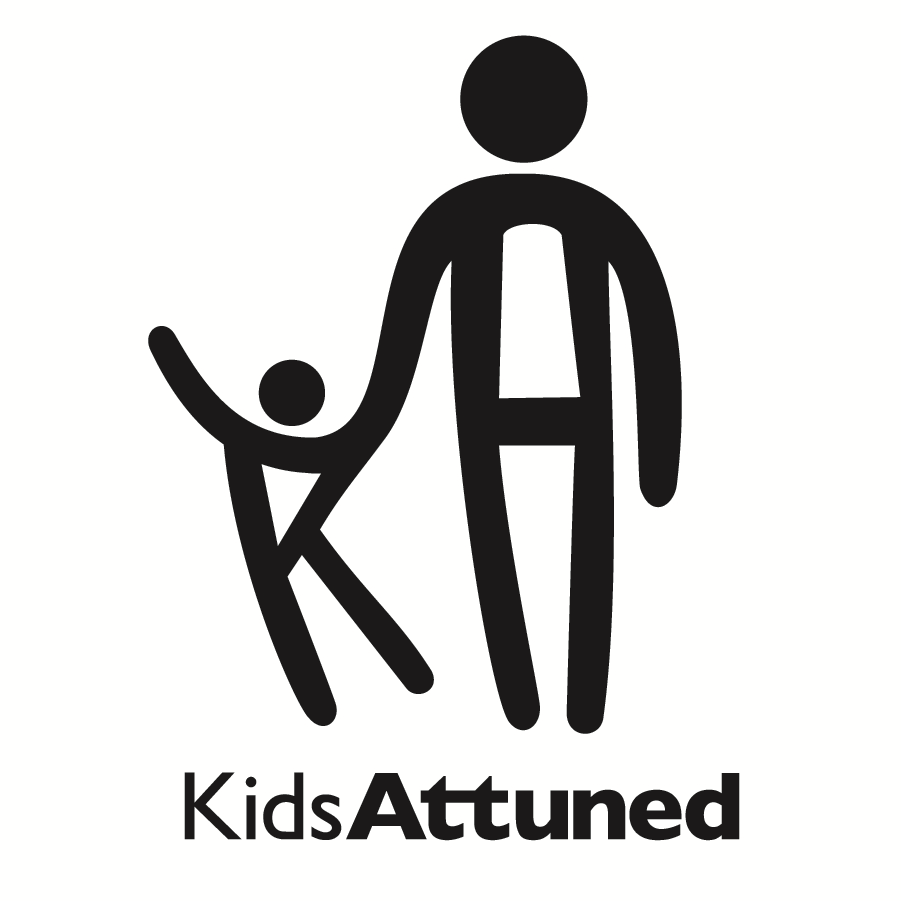Dual Coded: How the meaning we make through the sensory-motor-affective cueing system influences our social and emotional development
“The human capacities for love and for learning are rooted in the sensory-motor period of development, the first 18 months of life.“(Selma Fraiberg, 1980)
When you were a baby, chances are good you loved being held and rocked in your parent’s arms while they looked into your eyes lovingly and spoke softly to you. This felt good physically and emotionally. It was the beginning of your ability to know you were loved and cared for.
From birth, you were able to integrate sensory input across several sensory systems and perceive the good feelings simultaneously. Your tactile system could positively receive the sensation of your parent’s body next to yours. Your visual system could reciprocate loving looks from your parent by looking back into your parent’s eyes with a gleam that reinforced the perception that your parent knew what felt good to you. Your proprioceptive system (the sensations governing body awareness) felt secure and comfortable with the just right amount of pressure your parent used to hold you safely. Your vestibular system (the sensations governing balance and spatial awareness) felt the rhythmic connection to your parent’s own movements, much like the rhythms you felt while you were in the womb.
Amazingly, although you were just days old, you could integrate these sensory and motor sensations into a coherent experience, and you coded all these sensations as emotionally pleasurable. The sensory motor-affective cuing system was working full steam and on automatic pilot.
No one notices this little miracle unless there’s a glitch in the system. Suppose the surface of your skin felt prickly when you were held in your parent’s arms. Your tactile experience might have caused you to code your emotional experience as unsafe, uncomfortable, or irritated. You’d let your parent know by crying, pulling away, or turning away. When the sensory systems register input as unpleasant, the emotional code reads threat/ danger and unhappiness for both parent and baby.
Instead of looking back at your parent’s eyes, you try to protect yourself by terminating contact and looking away. Perhaps you are protecting yourself from unpleasant stimulation in the only way you can because the visual stimulation is too much for you to take in. The emotional coding for baby and parent is to cut off gaze and withdraw affectively.
What happens if the proprioceptive and vestibular systems react with fear of falling, dizziness, or nausea? Both baby and parent send emotional signals to each other limiting contact and synchronized movement. Instead of a well-orchestrated symphony of sensory and motor input organized with secure, loving feelings between parent and infant, the emotional music is discordant, and fragmented, and leaves both parent and infant with a feeling to flee or shut down contact.
Movement needs to feel organized and under our control for us to feel safe. The way we experience movement and sensory sensations from the earliest experiences in life sets the patterns for how we make meaning from our contact with another person. These meanings govern interactions long before the infant or child has any verbal language facility available to mediate the interpersonal world.
In this posting, we’ll explore the interaction between individual differences in sensory-motor processing and challenges in co-creating meaningful connections and in building social–emotional relationships.
VARIABLES INFLUENCING THE INTERACTIVE SYSTEM: It’s a two-way street
Sensory processing in the parent and the child
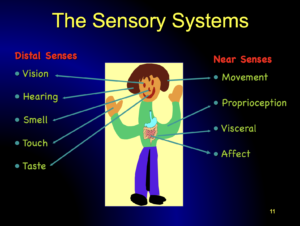
Sensory processing is defined as the ability to organize sensory information for our functional use.
This involves:
- Registration and Orientation
- Regulation
- Interpretation – Affective & Contextual Meaning
- Organization of a Response
- Execution of an action
To organize the input, we need to be able to register that information is coming our way, orient our bodies, vision, and hearing toward the input, modulate the intensity of the input coming toward us, and interpret or make meaning out of it, both affective and contextual meaning. Finally, once we’ve navigated all these elements of processing, we can organize our response.
We all have our unique sensory processing profiles. Sometimes child centered providers fail to take note of the parents’ processing profiles. Sometimes providers look through the lens of their discipline-specific training only, without attention to all the other systems influencing a person’s meaning-making and response. I’m calling attention to the need to integrate our understanding to include all sensory domains, emotional responses, and the registration and interpretation that takes place in the parent and in the infant to derive meaning.
Video Illustration
The following video vignette illustrates the sensory-motor and affective effect of a challenging sensory context on a young boy faced with a situation parents and the public assume will be pleasurable for the child. Notice how the child shuts down and attempts to withdraw from the demands of the situation. This is his best effort at self-protection in this context. Think about the early sense of shame when he can not meet his parent’s expectations.
Once sensory input is interpreted, a child has to organize a response to the input. How does the child show intention to act on the sensory input? This requires temporal processing which is variable internally and dependent upon how many sources of input are impacting a child at the time. Is there a long delay before responding? Is the child impulsive and reactive with a quick response? Can the child respond while the interactive partner is still attentive but takes enough time to plan a response? Or does the child fail to have any response at all, almost as if she/he didn’t register or interpret the input in the first place?
The following photos illustrate the organization of a response using affect, the motor system, and cognition as means of communication.
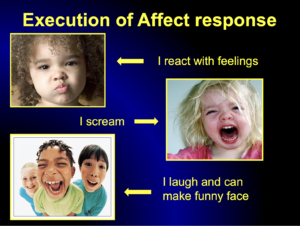
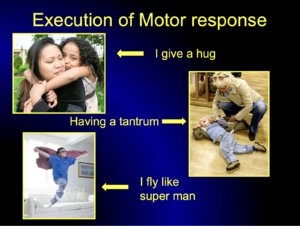
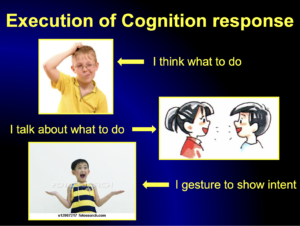
Self-regulation and co-regulation
Individual differences in sensory processing have a major effect on a child’s ability to maintain a calm and organized state, which is often called self-regulation. Foley and Baz, (2021) define self-regulation as the child’s developing capacity to flexibly modulate and grade reactivity to sensation, affect arousal and behavior, appropriate to the demands of the physical and social environment, and recover from dysregulated states, all with relative autonomy, in support of goal-directed actions across a broad range of functions. (Carver and Scheier, 2016; Foley 2017; Murray et al. 2015)
Early capacities for self-regulation are dependent upon smooth transitions between sleep and a quiet alert state, clear signals of hunger and satiation, and smooth digestive processes. Think of the baby who calmly smiles at his parent, and drowsily closes his eyes drifting off to sleep versus the baby who cries in an escalated way until he is held, rocked, and sung to sleep.
We need to pay attention to these differences in sensory processing because they have a significant effect on the baby and on the parent. All babies need their parents to help them sustain a calm and organized state of being. The parents are crucial contributors to the baby’s process of learning how to maintain regulation. How the parent notices the baby’s state, interprets the baby’s actions and vocalizations, and steps in to calm the baby with facial expression, touch, voice tone, and prosody all contribute to the dyad working out an interactive system for being together. The actions of the parent or caregiver help the baby to be calm, alert, and attentive in a system of co-regulation. Co-regulation is what parents do with infants and children all the time.
CONFUSING SOCIAL PARTNERS MAKE CO-REGULATION CHALLENGING
Infants and children with challenging sensory–regulatory profiles have trouble focusing their attention, socializing with others, and developing routine patterns of sleeping, eating, and eliminating, and organizing their emotions and behavior. Parenting an infant who is a confusing social partner due to these sensory challenges often leaves the parent perplexed as to how to find moments of meeting with the baby or how to offer adaptive co-regulation.
Many of the infants’ responses are self-protective, though this is not obvious to the parents who are feeling worried, sad, or inadequate in their parenting. The baby’s responses are interpreted by parents as signals of avoidance or as nonverbal messages to back off. For example, the baby who experiences discomfort in a parent’s arms may wiggle away, avert gaze, and vocalize discomfort, sending a message the parent interprets as ‘my baby is happier when I leave him on the blanket or in the crib alone.’ Or the baby who processes input very slowly, compared to the caregivers, may have a parent who assumes the baby is not interested or not responsive because, by the time the infant organizes a response, the parent has shifted attention to some other focus.
Helping parents observe the baby’s unique timing and responses can pave the way for the parent to adapt to their individual baby. If a parent is feeling ineffective and tentative in their approach to the baby, they may be focusing on their own worries and internal state which could create stumbling blocks to their curiosity about what the baby might be experiencing or feeling. The parent might misinterpret the baby’s signals as a criticism of their parenting. The parent and baby are searching for the moments in which they each feel met by the other; safe, understood, and connected.
Through these moments of connection, the parent learns what to do with their body, their movement, their facial expression, the rhythm of their voice, and the proximity and intensity of their gaze. Moments of shared mutual connection emerge and stabilize. This understanding of the baby’s needs often develops outside of the parents’ conscious awareness.
Various terms have been used to describe the infant-caregiver connection. The following terms are widely in use. Intersubjectivity, (Trevarthen, C.1998) is defined as the infant’s ability to adapt or fit to the subjectivity of others. Interactional synchrony, (Feldman, R. 2007) is defined as the unconscious coordination of behaviors between partners during social interaction and across communicative modalities. Shared attention, (Greenspan & Wieder 2006) is defined as the infant’s ability to focus, be calm, and actively take in information from their experiences. These concepts have been used in the literature to describe the feeling states, attention, vocalization, and movement that characterize moments of infant-parent connection.
We are looking at an interactive system made up of the infant’s emerging internal representations, feeling states, and interoceptive experience plus the infant’s experience in the social and physical context, as well as the internal and contextual experience of the parent or primary caregivers. For both infant and parent, the sensations in the body inform the emotional meaning of the moment.
CONCEPT OF THRESHOLD: how we manage sensory input
Everyone has an individual threshold in each sensory domain that can vary depending on other stressors affecting the person and can be as unique to that person as their fingerprint. The threshold is the point at which sensory input activates the central nervous system. When it takes a lot of input to get a reaction, that sensory domain is hypo-reactive, or hypo-responsive. When it takes just a little input to get a reaction, that sensory domain is hyper-reactive, or hyper-responsive.
Think of the person who would never shop in a big box store because there is too much visual stimulation, (hyper-responsive in the visual system), but who loves to go to rock and roll concerts, the louder the better, (hypo-responsive in the auditory system.)
Video of sensory responsivity
The following video illustrates the concepts of reactivity leading to different thresholds using an analogy of filling a cup. In sensory domains where we are hyper-reactive or responsive, our cup is small and quick to overflow. In sensory domains where we are hypo-reactive or responsive, our cup is large and we seem to never get enough.
Here are some examples of how differences in thresholds can be a source of confusion or difficulty in relationships. These challenges can arise from misinterpretation of the state of the parent and of the baby, and the sources of sensory sensitivity.
Let’s think about the baby who can not nurse if other people are talking, the TV is on, or music is filling the room. The nursing parent feels the failure in the feeding and may wonder why the baby is not interested, or fussy every time she tries to latch on. The baby’s hypersensitivity to auditory input is most apparent in the moment she is trying to integrate sound with being held and feeling hunger. What transpires becomes a pattern of interaction in which the parent feels anxious every time she offers the breast. Maybe her body stiffens slightly sending a message to the baby that stimulates a stiffness in the baby’s body or a gaze aversion – Mom wants to feed me, but she also doesn’t want to feed me. The feelings associated with the baby’s sensory hyper-responsivity begin to form an interactive system of hesitation, anxiety, and approach avoidance.
A classic example is the child who is being called from another room to come to the dinner table. The parent calls in a normal voice… no response. The voice volume escalates, calling the child again…no response. The parental voice tone becomes irritated and much louder… still no response. Exasperated, the parent comes into the room where the child is playing, touches the child gets down at eye level, speaks in an irritated but normal voice volume, and the child looks at the parent and says “Huh?”. Is it possible the child didn’t hear the parent calling from the other room? The answer is yes.
We all have our unique filters for attending to sensory information in our environment. Attention depends on our natural responsivity in that sense domain plus the threshold and the accumulation of other demands on our sensory and emotional processing. The parent who is adaptive, and beyond conscious awareness shifts attention easily, may find it outside their imagination that their child has trouble discerning which sensory inputs are salient and when to shift attention from one source of input to another. The parent can’t believe that their child didn’t hear them. This is one example but imagine this sensory-sensitive interactional system at play throughout the daily life of the family members.
As we look at dyadic synchrony (the continuous flow of back-and-forth reciprocal interaction between 2 people) we can begin to imagine how many variables are influencing the behavior and responses of each person. How many sensory systems are engaged? Are the parent and child registering the same input as salient and responding to each other’s responses? Is the baby looking for a big response from a parent who feels overwhelmed by their own big feelings? For the most part, parents and children execute this dance of temporal sequences, synchronized rhythm, and coordinated visual, vocal, and movement activity intuitively, seemingly without thought.
When it is challenging to comprehend a partner’s intention, read facial and gestural cues, and move and vocalize in fluid synchrony, the co-regulation between partners becomes illusive, and intuition or instinctive reactions are thwarted. This is often the beginning of a pattern of spiraling away from: feelings of emotional connection, seeking the other’s attention, and watching the other to read their intention. When we encounter infants or young children and their parents stuck in these patterns of missed cues and miscues, we often see parents who are becoming more directive, or more withdrawn from the child, leaving the child overwhelmed or alone at the very moment the child most needs parental understanding, co-regulation, and emotional connection.
Providers across all disciplines have an opportunity at these moments to become interpreters for the baby so that parents and caregivers can bring empathy and a new understanding to their interactions with their child.
References
Feldman R (2007). Parent-infant synchrony and the construction of shared timing; Physiological precursors, developmental outcomes, and risk conditions. Journal of Child Psychology and Psychiatry, and Allied Disciplines, 48(3–4), 329–354. 10.1111/j.1469-7610.2006.01701.x
Foley, G.M. and Baz, T. (2021) Aggression in young children on the autistic spectrum: the dysregulation – “aggression” hypothesis. In (Eds.). Neophytos, P.L. and Undurti, D. N., Emerging Programs for Autism Spectrum Disorder. Elsevier.
Greenspan, S. I., & Wieder, S. (2006). Engaging autism: Using the floortime approach to help children relate, communicate, and think. Da Capo Lifelong Books.
Trevarthen, C. (1998). The concept and foundations of infant intersubjectivity. In S. Bråten (Ed.), Intersubjective communication and emotion in early ontogeny (pp. 15–46). Cambridge University Press.
Special thanks to Beth Osten, Ph.D., OTR and to Easter Seals for the visuals.
Enter the text or HTML code here
